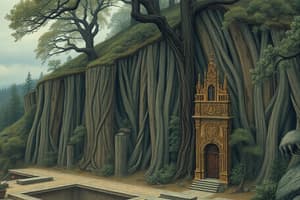Podcast
Questions and Answers
What are the expected outcomes after going through this module?
What are the expected outcomes after going through this module?
Enumerate the causes of a landslide and a sinkhole, explain the causes, and accurately conclude the causes and their respective geological hazards.
The self-learning module (SLM) is prepared for _____ learners.
The self-learning module (SLM) is prepared for _____ learners.
dear
The module includes post-tests to measure knowledge.
The module includes post-tests to measure knowledge.
True (A)
What should learners do if they have questions using this SLM?
What should learners do if they have questions using this SLM?
What is the primary focus of this module?
What is the primary focus of this module?
Who designed and wrote this module?
Who designed and wrote this module?
Learners need to answer exercises and tests on a _____ sheet of paper.
Learners need to answer exercises and tests on a _____ sheet of paper.
Which of the following is not considered a natural cause of landslides?
Which of the following is not considered a natural cause of landslides?
What effect does significant rainfall have on groundwater levels?
What effect does significant rainfall have on groundwater levels?
What phenomenon is responsible for saturating the soil, contributing to landslides?
What phenomenon is responsible for saturating the soil, contributing to landslides?
Which of the following actions can lead to landslides?
Which of the following actions can lead to landslides?
Which process leads to the deterioration of rocks, making them more susceptible to landslides?
Which process leads to the deterioration of rocks, making them more susceptible to landslides?
Which technique involves vibrations that weaken soil due to blasting?
Which technique involves vibrations that weaken soil due to blasting?
Which factor is responsible for causing dissolution sinkholes?
Which factor is responsible for causing dissolution sinkholes?
How does groundwater pumping contribute to sinkhole formation?
How does groundwater pumping contribute to sinkhole formation?
Which statement regarding the effects of frequent soil submersion in water is correct?
Which statement regarding the effects of frequent soil submersion in water is correct?
What is true about the impact of ground slope on landslides?
What is true about the impact of ground slope on landslides?
Flashcards are hidden until you start studying
Study Notes
Causes of Geological Hazards
- This learning module will focus on geological hazards.
- The module will help readers learn about landslides and sinkholes.
- The goal of this module is to help readers understand the causes of landslides and sinkholes.
- The module aims to help readers be able to accurately determine the causes of landslides and sinkholes.
Causes of Landslides
- Landslides are a downward movement of rock and debris, often resulting from the removal of supporting earth at the base of an incline.
- Natural Causes of Landslides:
- Climate: Heavy rainfall can saturate the ground, making it more vulnerable to slippage.
- Erosion: The gradual wearing away of soil and rock by wind or water can weaken slopes.
- Weathering: The process of rock deterioration due to exposure to the elements weakens landslide-prone materials.
- Tectonic Plate Movements: These movements can cause the ground on steep slopes to shift, leading to landslides.
- Human-Caused Landslides:
- Clear-cutting: Removing trees from a slope can destabilize the soil, making it more susceptible to landslides.
- Mining: Excavation and removal of earth can lead to slope instability, resulting in landslides.
- Cultivation: Repeated tillage and farming practices can loosen the soil and expose it to erosion, increasing landslide risk.
- Liquefaction: Strong shaking during an earthquake can cause loose, saturated soil to behave like a liquid, increasing the likelihood of landslides.
- Factors Affecting Slope Stability:
- Soil Nutrients: Nutrients in soil can impact the strength and stability of slopes.
Effects of Landslides
- Death: Landslides can bury people and cause fatalities.
- Depopulation: Landslides can cause widespread destruction, displacing communities.
- Damage to Property: Landslides can damage buildings, roads, and other infrastructure.
Types of Landslides
- Slumping: A slow, downward movement of a block of earth along a curved surface.
- Debris Flow: A fast-moving landslide consisting of a mixture of water, soil, and rocks.
- Rock Fall: A sudden and rapid slide of rock down a slope.
Causes of Sinkholes
- Natural Causes:
- Dissolution of Sedimentary Rocks: The dissolution of rocks like limestone creates voids in the ground, which can collapse and form sinkholes.
- Cover Collapse Sinkholes: Occur where there's a significant clay content in covering sediments, forming abruptly and causing significant damage.
- Cover Subsidence Sinkholes: Occur when covering sediments are permeable and contain sand. They form gradually and are often smaller, making them less noticeable.
- Dissolution Sinkholes: Form in areas where limestone is exposed or covered by thin layers of soil. They are small and develop slowly.
- Human-Caused Sinkholes:
- Groundwater Pumping: The removal of groundwater can alter drainage patterns, erode soil, and create voids that lead to sinkholes.
- Construction Activities: Excavation and changes in weight can contribute to sinkhole formation.
- Mining: Mining activities can create voids and weaken underground support, increasing the risk of sinkholes.
- Drilling: Drilling can disrupt the stability of the ground, leading to sinkholes.
- Artificial Ponds: The construction of artificial ponds can increase water flow and erosion, potentially causing sinkholes.
Effects of Sinkholes
- Damage to Property: Sinkholes can damage buildings, roads, and other infrastructure.
- Loss of Life: Sinkholes can collapse suddenly and cause injuries or fatalities.
- Environmental Impacts: Sinkholes can disrupt natural water systems and cause pollution.
Relationship Between Gravity and Landslides
- Steeper Slope:
- More likely to trigger a landslide.
- Can lead to a faster landslide.
- Can cause debris to travel further.
How Forest Fires Can Cause Landslides
- Soil Water Resistance: Forest fires can make soil water-resistant.
- Burning of Vegetation: Forest fires can burn resin, oil, and fat stored in vegetation, making soil more prone to erosion.
- Increased Runoff: The loss of vegetation after a fire can lead to increased runoff, which can erode soil and trigger landslides.
How Volcanic Eruptions Can Cause Landslides
- Volcanic Gas: Volcanic gas dissolved in groundwater can weaken rocks, increasing the likelihood of landslides.
- Vibrations: Volcanic eruptions can cause vibrations that loosen the soil surrounding the volcano, making it more susceptible to landslides.
- Altering Minerals: Volcanic eruptions can alter minerals, forming clay that weakens the soil.
Studying That Suits You
Use AI to generate personalized quizzes and flashcards to suit your learning preferences.




